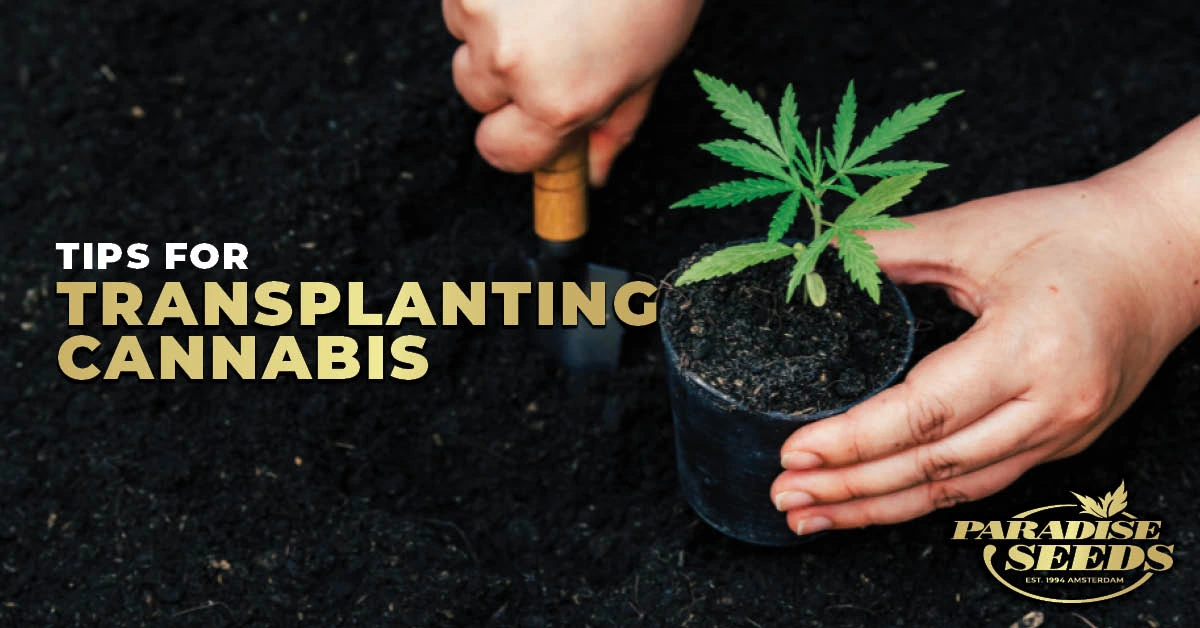For beginners who are growing cannabis for the first time, there can be uncertainty about when to transplant cannabis plants. This article gives a guide to transplanting cannabis seedlings and how to carry out the process safely and avoid common mistakes.
When is it necessary to transplant cannabis plants?
The simple answer to the question of when to transplant cannabis plants is that plants need to be transplanted when they outgrow their growing medium. This process includes young seedlings, started in a small pot from a planted cannabis seed, or more established plants which are running out of space in their pots. Plants which are placed direct into the ground do not need transplanting, although it is common to start seeds off in smaller pots to nurture them to seedling stage so they are big enough to survive in the soil.
Why do growers need to transplant weed plants?
You need to transplant cannabis plants in order to maintain healthy growth. If a plant does not have space to grow (for example within the confines of a pot which is too small) then the root system will become restricted and start to cause cultivation issues. The most common evidence of a restricted root system (often referred to as ‘root bound’) is stunted growth or unhealthy plants. Tell tale signs include slow growth or the plant growing upwards without much side branch development.
What are the signs that a plant needs transplanting?
If you are using conventional pots, then an obvious indication of when to transplant cannabis plants is when you can see the roots through the drainage holes at the bottom. Other signs are slowing plant growth or signs of wilting.
What are the risks involved when growers transplant cannabis plants?
This process is stressful for plants (not to mention growers) as root hairs are sensitive and fragile. Transplanting cannabis seedlings removes them from their safe environment and in clumsy hands the root system can easily be broken.
What is the best way to transplant cannabis seedlings?
Carefully!… Joking aside, timing is important when transplanting, especially outside. Firstly plants should be healthy to prepare them for this stressful transition:
- Thoroughly water the day before so there is a lot of moisture in the soil content.
- Try to transplant when it is overcast and leave later in the day, so that the plant has a night to rest before the light and sun of the next day arrives.
- Scoop out a little hole in the soil in the new pot or ground (make sure the hole is deep enough to house the plant and its root ball– a common mistake!). Make sure this is well watered so the roots come into contact with moist soil straight away.
- Give the plant water shortly before you transplant it so its roots are also moist.
- Lightly squeeze around the edges of a (plastic) pot and gently remove the seedling and place it into the hole.
- Smooth the earth around it and pat it down to secure the seedling in place.
- Water again.
- Ideally protect the plant from direct sunlight for at least 3 days to give it time to recover.
Can you avoid transplanting cannabis seedlings from small pots to bigger pots?
While small plastic pots offer a decent medium with good drainage, environmentally friendly options are always a preferred choice. If small plastic pots are used, a popular gardener’s trick is to remove the bottom and plant direct in the new bigger pot, although this takes some pre-planning (ie making cut lines before planting the seeds to ease the removal when the time comes).
Peat pots are popular because they biodegrade, so the small seedling pot can be transferred directly into a bigger pot where it will rot down and allow the roots to expand. However, peat removal also has ramifications for the environment and so many gardeners are looking for alternative materials such as pots made from newspaper or even cow manure, which will also rot down. One word of caution with these alternative mediums is to make sure they don’t dry out.
Is it necessary to transplant Autoflower plants?
Due to the lifecycle of plants grown from autoflower cannabis seeds, it is advisable not to transplant them. This is because of the risk of stressing the plant and the ensuing recovery time which will be detrimental to the plant’s potential to achieve maximum growth within its growth window – which is usually between 65 and 80 days from planting the cannabis seed to harvest time. Auto growers are advised to begin the seed in the pot it will live its life in or grow seeds to seedlings in small biodegradable pots that can be placed inside larger ones when the time is necessary.
Transplanting cannabis is a necessary part of the cannabis growing process for most growers and can be a stressful moment. However, with the above tips and gentle handling, most seedlings will soon happily respond to their new environment!


